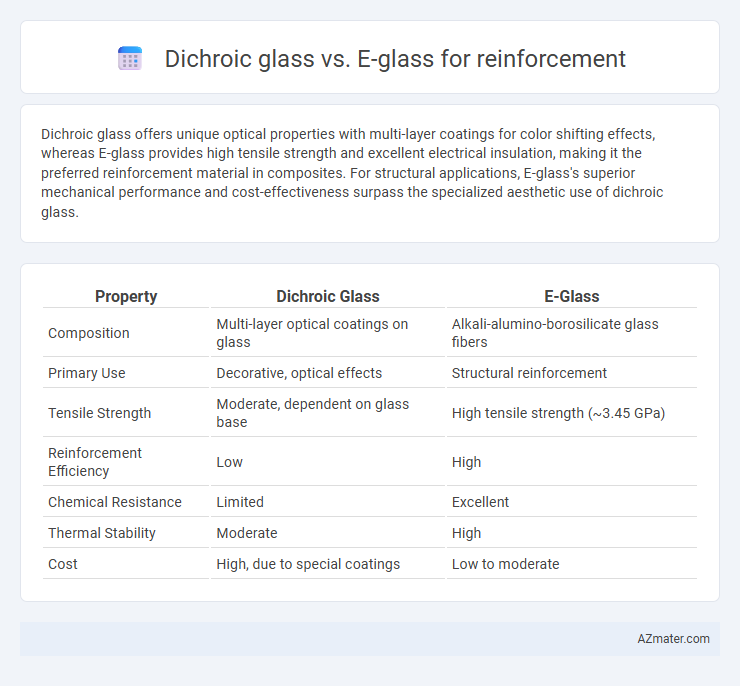Dichroic glass offers unique optical properties with multi-layer coatings for color shifting effects, whereas E-glass provides high tensile strength and excellent electrical insulation, making it the preferred reinforcement material in composites. For structural applications, E-glass's superior mechanical performance and cost-effectiveness surpass the specialized aesthetic use of dichroic glass.
Table of Comparison
| Property | Dichroic Glass | E-Glass |
|---|---|---|
| Composition | Multi-layer optical coatings on glass | Alkali-alumino-borosilicate glass fibers |
| Primary Use | Decorative, optical effects | Structural reinforcement |
| Tensile Strength | Moderate, dependent on glass base | High tensile strength (~3.45 GPa) |
| Reinforcement Efficiency | Low | High |
| Chemical Resistance | Limited | Excellent |
| Thermal Stability | Moderate | High |
| Cost | High, due to special coatings | Low to moderate |
Introduction to Glass Fiber Reinforcement
Glass fiber reinforcement primarily utilizes E-glass due to its excellent tensile strength, chemical resistance, and cost-effectiveness, making it ideal for composites in automotive and aerospace industries. Dichroic glass, known for its optical properties and color-shifting capabilities, is generally not used as reinforcement but valued in decorative applications and artistic glasswork. Selecting the appropriate glass fiber depends on mechanical performance requirements and functional purposes rather than solely on aesthetic properties.
Dichroic Glass: Characteristics and Applications
Dichroic glass exhibits unique optical properties by displaying multiple colors through interference filters, making it highly prized in decorative and artistic applications. Its composition involves micro-thin layers of metallic oxides, which provide durability but do not offer the same structural reinforcement strength as E-glass, commonly used in composite materials. While dichroic glass enhances aesthetic value and light manipulation in architectural panels and jewelry, E-glass remains the preferred choice for mechanical reinforcement in aerospace, automotive, and marine industries due to its superior tensile strength and impact resistance.
E-Glass: Properties and Industry Standards
E-glass, known for its high tensile strength and excellent electrical insulation properties, is a staple reinforcement material in the composites industry, widely used in aerospace, automotive, and marine applications due to its cost-effectiveness and durability. Unlike Dichroic glass, E-glass fibers are composed primarily of alumino-borosilicate and meet stringent industry standards such as ASTM D4772 and ISO 2078, ensuring consistent performance in fiberglass manufacturing. Its superior mechanical properties, including high stiffness and resistance to chemical corrosion, make E-glass the preferred choice for structural reinforcement in composite materials.
Comparative Strength: Dichroic Glass vs E-Glass
Dichroic glass offers unique optical properties but lacks the tensile strength and durability found in E-glass, making E-glass the preferred choice for reinforcement applications requiring high mechanical performance. E-glass, composed primarily of alumino-borosilicate glass, provides superior fracture resistance and consistent tensile strength typically around 3400 MPa, outperforming dichroic glass fibers. While dichroic glass may be used decoratively or in specialized composites, E-glass remains the standard for reinforcement due to its cost-effectiveness and robust structural properties.
Durability and Weather Resistance
Dichroic glass offers moderate durability but is primarily valued for its color-shifting optical properties rather than structural reinforcement. E-glass, engineered from alumino-borosilicate fibers, provides superior strength, excellent impact resistance, and outstanding weather resistance, making it the preferred choice for reinforcement in composites exposed to harsh environmental conditions. Its resilience against moisture, UV radiation, and temperature fluctuations ensures long-term structural integrity in aerospace, automotive, and marine applications.
Optical and Aesthetic Differences
Dichroic glass exhibits vibrant, shifting colors due to its multiple thin-film layers, offering superior aesthetic appeal and dynamic optical effects compared to E-glass, which is primarily transparent and colorless. E-glass reinforcement emphasizes mechanical strength and durability rather than visual impact, making it ideal for structural applications without significant light manipulation. The dichroic glass's ability to reflect and transmit various wavelengths of light creates unique visual textures uncommon in the traditional, highly resilient E-glass fibers.
Cost Analysis: Dichroic vs E-Glass
Dichroic glass typically incurs higher costs compared to E-glass due to its specialized manufacturing process involving multiple metal oxide layers that produce unique light-reflecting properties. E-glass, widely used in reinforcement applications, offers a cost-effective solution with consistent mechanical performance and broad availability. When evaluating reinforcement materials, E-glass proves economically advantageous, especially for large-scale projects, while dichroic glass is suited for niche applications where optical properties justify the premium price.
Compatibility with Resin Systems
Dichroic glass and E-glass differ significantly in compatibility with resin systems due to their distinct chemical compositions and surface properties. E-glass, a widely used fiberglass variant, exhibits excellent bonding with polyester, vinyl ester, and epoxy resins owing to its silica-alumina-calcium oxide composition and well-established sizing agents. In contrast, dichroic glass, primarily known for its reflective coatings and optical properties, may require specialized surface treatments to enhance adhesion and ensure compatibility with typical composite resin matrices.
Environmental Impact and Sustainability
Dichroic glass and E-glass differ significantly in environmental impact and sustainability, with E-glass being the more commonly used fiber reinforcement made from abundant silica sand and offering recyclability options that reduce landfill waste. Dichroic glass, primarily valued for its optical properties, involves complex coatings and manufacturing processes that increase energy consumption and generate more waste during production. Choosing E-glass supports greener composites manufacturing due to its established recycling infrastructure and lower embodied energy compared to the specialized, resource-intensive dichroic glass.
Choosing the Right Glass for Reinforcement
Dichroic glass provides unique optical properties like color-shifting effects, making it ideal for decorative applications but less suited for structural reinforcement due to lower mechanical strength compared to E-glass. E-glass is the industry standard for reinforcement in composites, offering high tensile strength, chemical resistance, and cost-effectiveness essential for load-bearing and structural components. Selecting the right glass for reinforcement depends on balancing aesthetic requirements with performance needs, where E-glass excels in durability and dichroic glass is reserved for visual enhancement.

Infographic: Dichroic glass vs E-glass for Reinforcement
 azmater.com
azmater.com